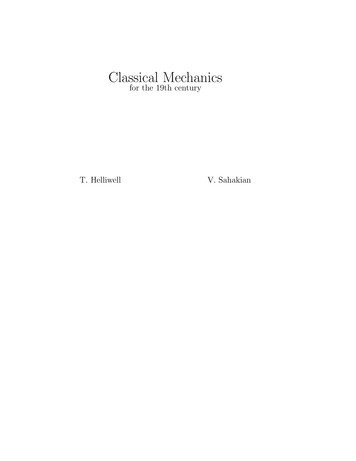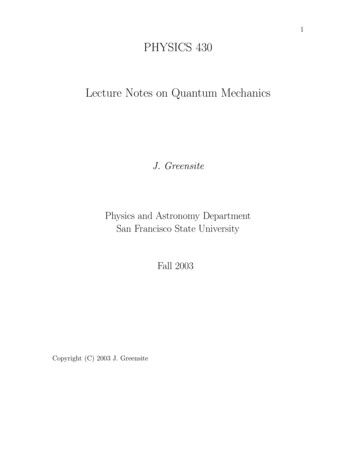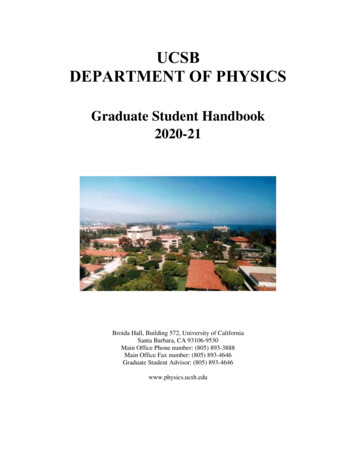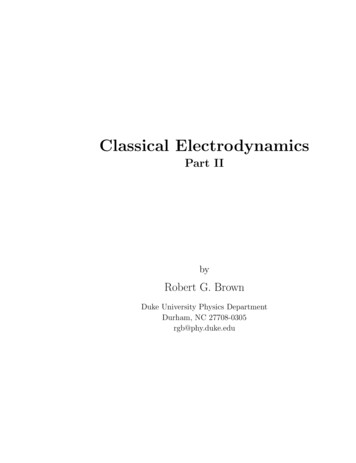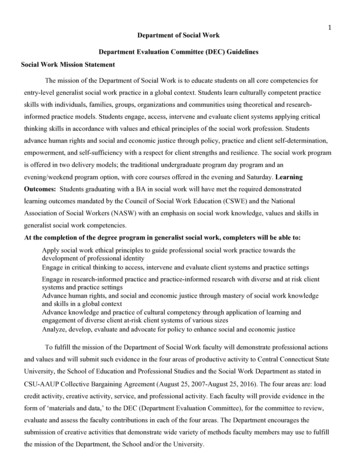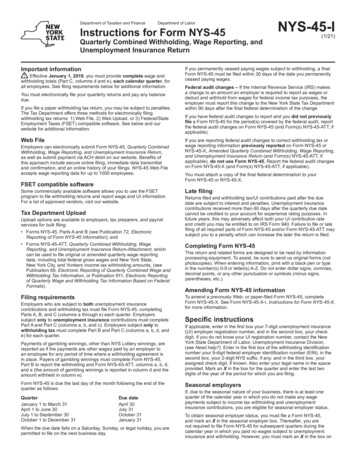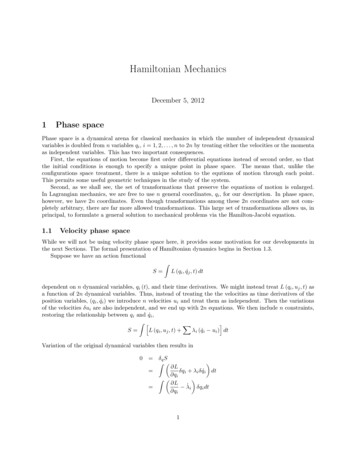
Transcription
Hamiltonian MechanicsDecember 5, 20121Phase spacePhase space is a dynamical arena for classical mechanics in which the number of independent dynamicalvariables is doubled from n variables qi , i 1, 2, . . . , n to 2n by treating either the velocities or the momentaas independent variables. This has two important consequences.First, the equations of motion become first order differential equations instead of second order, so thatthe initial conditions is enough to specify a unique point in phase space. The means that, unlike theconfigurations space treatment, there is a unique solution to the equtions of motion through each point.This permits some useful geometric techniques in the study of the system.Second, as we shall see, the set of transformations that preserve the equations of motion is enlarged.In Lagrangian mechanics, we are free to use n general coordinates, qi , for our description. In phase space,however, we have 2n coordinates. Even though transformations among these 2n coordinates are not completely arbitrary, there are far more allowed transformations. This large set of transformations allows us, inprincipal, to formulate a general solution to mechanical problems via the Hamilton-Jacobi equation.1.1Velocity phase spaceWhile we will not be using velocity phase space here, it provides some motivation for our developments inthe next Sections. The formal presentation of Hamiltonian dynamics begins in Section 1.3.Suppose we have an action functionalˆS L (qi , q̇j , t) dtdependent on n dynamical variables, qi (t), and their time derivatives. We might instead treat L (qi , uj , t) asa function of 2n dynamical variables. Thus, instead of treating the the velocities as time derivatives of theposition variables, (qi , q̇i ) we introduce n velocities ui and treat them as independent. Then the variationsof the velocities δui are also independent, and we end up with 2n equations. We then include n constraints,restoring the relationship between qi and q̇i ,ˆ hiXS L (qi , uj , t) λi (q̇i ui ) dtVariation of the original dynamical variables then results in0 δq S ˆ L δqi λi δ q̇i dt qi ˆ L λ̇i δqi dt qi1
so thatλ̇i L qiFor the velocities, we find0 δu S ˆ L λi δui dt uiso that L uiand finally, varying the Lagrange multipliers, λi , we recover the constraints,λi ui q̇iWe may eliminate the multipliers by differentiating the velocity equation dd L(λi ) dtdt uito find λ̇i , then substituting for ui and λ̇i into the qi equation,λ̇i d Ldt q̇i d L L dt q̇i qi d Ldt q̇i L qi 0and we recover the Euler-Lagrange equations. If the kinetic energy is of the formLagrange multipliers are just the momenta,λi1.2 L uimui mq̇i Pn12i 1 2 mui ,then thePhase spaceWe can make the construction above more general by requiring the Lagrange multipliers to always be theconjugate momentum. Combining the constraint equation with the equation for λi we haveλi L q̇iWe now define the conjugate momentum to be exactly this derivative,pi Then the action becomesS ˆ hˆ h L q̇iL (qi , uj , t) Xpi q̇i Xipi ui dtL (qi , uj , t) Xpi ui Xipi q̇i dt2
For Lagrangians quadratic in the velocities, the first two terms becomeXXL (qi , uj , t) pi ui L (qi , q̇, t) pi q̇iX T V pi q̇i (T V )We define this quantity to be the Hamiltonian,XH pi q̇i L (qi , q̇, t)ThenS ˆ hXipi q̇i H dtThis successfully eliminates the Lagrange multipliers from the formulation.The term “phase space” is generally reserved for momentum phase space, spanned by coordinates qi , pj .1.2.1Legendre transformationNotice that H is, by definition, independent of the velocities, sinceXH pj q̇j L X Hpj q̇j L q̇i q̇ij Xpj δij j pi L q̇i L q̇i 0Therefore, the Hamiltonian is a function of qi and pi only. This is an example of a general technique calledLegendre transformation. Suppose we have a function f , which depends on independent variables A, B anddependent variables, having partial derivatives f A f B P QThen the differential of f isdf P dA QdBA Legendre transformation allows us to interchange variables to make either P or Q or both into theindependent variables. For example, let g (A, B, P ) f P A. Thendg df AdP P dA P dA QdB AdP P dA QdB AdP3
so that g actually only changes with B and P , g g (B, P ). Similarly, h f QB is a function of (A, Q)only, while k (f P A QB) has (P, Q) as independent variables. Explicitly,dk df P dA AdP QdB BdQ AdP BdQand we now have f P f Q2 A BHamilton’s equationsThe essential formalism of Hamilton’s equation is as follows. We begin with the actionˆS L (qi , q̇j , t) dtand define the conjugate momenta L q̇ipi and HamiltonianH (qi , pj , t) Xpj q̇j L (qi , q̇j , t)Then the action may be written asS ˆ hXipj q̇j H (qi , pj , t) dtwhere qi and pj are now treated as independent variables.Finding extrema of the action with respect to all 2n variables, we find:0 δqk S ˆ P j pj q̇j H δqk dtδ q̇k q̇k qk ˆ X H pj δjk δ q̇k δqk dt qkj ˆ Hδqk dt pk δ q̇k qk ˆ H ṗk δqk dt qkso thatṗk H qkand0 δpk S ˆ P j pj q̇j pk4 Hδpk δpk dt pk
ˆ Hq̇k δpk δpk dt pk ˆ Hq̇k δpk dt pkso that H pkThese are Hamilton’s equations. Whenever the Legendre transformation between L and H and between q̇kand pk is non-degenerate, Hamilton’s equations,q̇k H pk H qkq̇k ṗkform a system equivalent to the Euler-Lagrange or Newtonian equations.2.1Example: Newton’s second lawSuppose the Lagrangian takes the formL 1mẋ2 V (x)2Then the conjugate momenta arepi L ẋimẋiand the Hamiltonian becomesH (xi , pj , t) Xpj ẋj L (xi , ẋj , t)1mẋ2 mẋ2 V (x)21mẋ2 V (x)21 2p V (x)2mNotice that we must invert the relationship between the momenta and the velocities,piẋi mthen expicitly replace all occurrences of the velocity with appropriate combinations of the momentum.Hamilton’s equations are:ẋk H pkpkm H xk V xk ṗk thereby reproducing the usual definition of momentum and Newton’s second law.5
2.2ExampleSuppose we have a coupled oscillator comprised of two identical pendula of length l and each of mass m,connected by a light spring with spring constant k. Then for small displacements, the action is ˆ 11 2 22ml θ̇1 θ̇22 k (l sin θ1 l sin θ2 ) mgl (1 cos θ1 ) mgl (1 cos θ2 ) dtS 22which for small angles becomes approximately ˆ 1 1 2 212S ml θ̇1 θ̇22 k (lθ1 lθ2 ) mgl θ12 θ22 dt222The conjugate momenta are:p1p2 L θ̇1 ml2 θ̇1 L θ̇2 ml2 θ̇2 and the Hamiltonian isH p1 θ̇1 p2 θ̇2 L ml2 θ̇12 1 11 2 22222ml θ̇1 θ̇2 k (lθ1 lθ2 ) mgl θ1 θ2 222 1 1 2 212222ml θ̇1 θ̇2 k (lθ1 lθ2 ) mgl θ1 θ2222 1 11222p1 p2 k (lθ1 lθ2 ) mgl θ12 θ2222ml22ml2 θ̇22 Notice that we always eliminate the velocities and write the Hamiltonian as a function of the momenta, pi .Hamilton’s equations are:θ̇1 θ̇2 ṗ1 ṗ2 H p11p1ml2 H p21p2ml2 H θ11 kl2 (θ1 θ2 ) mglθ12 H θ21 2kl (θ1 θ2 ) mglθ226
From here we may solve in any way that suggests itself. If we differentiate θ̇1 again, and use the thirdequation, we haveθ̈1 1ṗ1ml21 1g 2 kl2 (θ1 θ2 ) θ1ml 2lk 1g (θ1 θ2 ) θ1m2lSimilarly, for θ2 we haveθ̈2k 1g(θ1 θ2 ) θ2m2l Subtracting,θ̈1 θ̈2 d2k(θ1 θ2 ) (θ1 θ2 )dt2m 0so thatrθ1 θ2 A sinAdding instead, we findkt B cosmrktmrgtlgθ̈1 θ̈2 (θ1 θ2 )lso thatrθ1 θ2 C sin3k 1k 1(θ1 θ2 ) (θ1 θ2 )m2m2gt D coslFormal developmentsIn order to fully appreciate the power and uses of Hamiltonian mechanics, we make some formal developments.First, we write Hamilton’s equations,ẋk ṗk H pk H xkfor k 1, . . . , n, in a different way. Define a unified name for our 2n coordinates,ξA (xi , pj )for A 1, . . . , 2n. That is, more explicitly,ξi xiξn i piWe may immediately write the left side of both of Hamilton’s equations at once asξ A (ẋi , ṗj )7
The right side of the equations involves all of the terms H H H , ξA xi pjbut there is a difference of a minus sign between the two equations and the interchange of xi and pi . Wehandle this by introducing a matrix called the symplectic form, 0 1ΩAB 1 0where[1]ij δijis the n n identity matrix. Then, using the summation convention, Hamilton’s equations take the form ofa single expression, Hξ A ΩAB ξBWe may check this by writing it out explicitly,! Hẋi0δij 0 xj Hṗi0 δi0 j0 pj 0! Hδij 0 pj0 H δi0 j xj! H pi H xi0In the example above, we have ξ1 θ1 , ξ2 θ2 , ξ3 p1 and ξ4 p2 . In terms of these, the Hamiltonianmay be written asHHABand with 1HAB ξA ξB2 kl2 mgl kl2 00 kl22kl mgl00001ml200001ml2 1 1H HAB δAC ξB HAB ξA δBC HCB ξB ξC22Hamilton’s equations are ξ1 ξ 2 ξ 3 ξ 4 0 0 10 000 1 2kl mgl1 0 kl20 1 0 000 000 0 kl2 mglkl2 100kl2 kl2 mgl ml2 ξ31 ml2 ξ4 2 kl ξ1 mglξ1 kl2 ξ2 kl2 ξ2 mglξ2 kl2 ξ181ml2000 kl202kl mgl010ml200 0ξ11 ml2 ξ2 0 ξ3 ξ400001ml2 ξ1 ξ2 ξ3 ξ4
so that ξ1 ξ 2 ξ 3ξ 4 1ml2 ξ31ml2 ξ4 kl2 (ξ1 ξ2 ) mglξ1kl2 (ξ1 ξ2 ) mglξ2 as expected.3.1Properties of the symplectic formWe note a number of important properties of the symplectic form. First, it is antisymmetric,Ωt ΩΩAB ΩBAand it squares to minus the 2n-dimensional identity, 0 1 1 0 Ω2 0 1 1 0 1 1 00 1 1 0 0 1We also haveΩt Ω 1since Ωt Ω, and therefore ΩΩt Ω ( Ω) Ω2 1. Since all components of ΩAB are constant, it isalso true that ΩBC 0 A ΩBC ξAThis last condition does not hold in every basis, however.The defining properties of the symplectic form, necessary and sufficient to guarantee that it has theproperties we require for Hamiltonian mechanics are that it be a 2n 2n matrix satisfying two propertiesat each point of phase space:1. Ω2 12. A ΩBC B ΩCA C ΩAB 0 0 1at any given 1 0point, while the vanishing combination of derivatives insures that this may be done at every point of phasespace.The first of these is enough for there to exist a change of basis so that ΩAB 3.2Conservation and cyclic coordinatesFrom the relationship between the Lagrangian and the Hamiltonian,H pi ẋi Lwe see that L H xi xi9
If the coordinate xi is cyclic, L xi 0, then the corresponding Hamilton equation reads ṗi H xi 0pi L ẋiand the conjugate momentumis conserved, so the relationship between cyclic coordinates and conserved quantities still holds.Since the Lagrangian is independent of pi , depending only on xi and ẋi , we also have a correspondingstatement about momentum. Suppose some momentum, pi , is cyclic in the Hamiltonian, H 0 piThen from either Hamilton’s equations or from the relationship between the Hamiltonian and the Lagrangian,we immediately haveẋi 0so that the coordinate xi is a constant of the motion.Suppose we have a cyclic coordinate, say xn . Then the conserved momentum takes its initial value, pn0 ,and the Hamiltonian isH H (x1 , . . . xn 1 ; p1 , . . . pn 1 , pn0 )and therefore immediately becomes a function of n 1 variables. This is simpler than the Lagrangian case,where constancy of pn makes no immediate simplification of the Lagrangian.Example 1: As a simple example, consider the 2-dimensional Kepler problem, with LagrangianL GM1 2m ṙ r2 θ̇2 2rThe coordinate θ is cyclic and therefore L mr2 θ̇ θ̇is conserved, but this quantity does not explicitly occur in the Lagrangian. However, the Hamiltonian is 1p2GMH p2r 2θ 2mrrl so pθ l is constant and we immediately have1H 2m l2GM2pr 2 rrExample 2 (problem 21a): Consider a flywheel of mass M and radius a, its center fixed . A rod oflength a is attached to the perimeter with its other end constrained to lie on a horizontal line through thecenter of the flywheel, and is attached to the massless rod of a simple pendulum of length l and mass m.Find the Hamiltonian.First, find L,11T mv2 I ϕ̇22210
where ϕ̇ (t) is the angular velocity of the flywheel andˆ MI33 x2 y 2 z 2 z 2 dxdydzπa2 dˆ Mx2 y 2 dxdy 2πaˆM ρ3 dρdϕπa22πM a4 πa2 41 M a22while the velocity of the pendulum bob is the combination of the swinging, lθ̇, and the oscillatory motion ofthe suspension point, located at 2a cos ωt. With the postion of m given byx 2a cos ϕ l sin θy l cos θthe velocity has componentsẋ 2aϕ̇ sin ϕ lθ̇ cos θẏ lθ̇ sin θTherefore,T 11mv2 I ϕ̇222 112m ẋ ẏ 2 M a2 ϕ̇224 11 2 2 2m 4a ϕ̇ sin ϕ 4alϕ̇θ̇ sin ϕ cos θ l2 θ̇2 M a2 ϕ̇224and the potential is simplyV mgl cos θup to an arbitrary constant. Therefore, 11 L m 4a2 ϕ̇2 sin2 ϕ 4alϕ̇θ̇ sin ϕ cos θ l2 θ̇2 M a2 ϕ̇2 mgl cos θ24To find the Hamiltonian, we first find the conjugate momenta,pθpϕ L θ̇ ml2 θ̇ 2malϕ̇ sin ϕ cos θ L ϕ̇ 14ma2 ϕ̇ sin2 ϕ 2malθ̇ sin ϕ cos θ M a2 ϕ̇2Next, find the Hamiltonian in terms of both velocities and momenta, 12222H ml θ̇ 2malϕ̇ sin ϕ θ̇ 4ma ϕ̇ sin ϕ 2malθ̇ sin ϕ M a ϕ̇ ϕ̇2 11 2 2 2 m 4a ϕ̇ sin ϕ 4alϕ̇θ̇ sin ϕ l2 θ̇2 M a2 ϕ̇2 mgl cos θ241 2 21 ml θ̇ 2malϕ̇θ̇ sin ϕ 2ma2 ϕ̇2 sin2 ϕ M a2 ϕ̇2 mgl cos θ24 11
Finally, solve for the velocities and eliminate them from H,θ̇ pϕ 2mal pϕ 2malθ̇ sin ϕ 2aϕ̇pθ sin ϕ sin ϕ ml2l2apθpϕ sin ϕ l ϕ̇ pθ2aϕ̇ sin ϕml2l14ma2 ϕ̇ sin2 ϕ M a2 ϕ̇214ma2 ϕ̇ sin2 ϕ M a2 ϕ̇214ma2 ϕ̇ sin2 ϕ M a2 ϕ̇ 4ma2 ϕ̇ sin2 ϕ2 122222ϕ̇ 4ma sin ϕ M a 4ma sin ϕ21M a2 ϕ̇224 sin ϕpϕ pθM a2alMand thenθ̇ 2aϕ̇pθ sin ϕml2lpθ8 sin2 ϕ4psinϕ pθ ϕ2ml2 M al l M418msin2 ϕ pθ pϕ sin ϕ1 ml2MM also finally,1 2 21H ml θ̇ 2malϕ̇θ̇ sin ϕ 2ma2 ϕ̇2 sin2 ϕ M a2 ϕ̇2 mgl cos θ24! 2 1 218sinϕ168m8m ml1 sin2 ϕ p2θ sin2 ϕ pϕ pθ 2 2 2 p2ϕ sin2 ϕ1 22MM mal3MM a l(ml2 ) 24 sin ϕ8m41 2malpϕ pθ1 sin2 ϕ pθ pϕ sin ϕ sin ϕM a2alMml2MM al 424 sin ϕ16 sin2 ϕ 212222p 2pϕpθ 2 2 2 pθ mgl cos θ 2ma sin ϕ M a4M 2 a4 ϕM a2alMa l M 2 4 sin ϕ8m18m8msin2 ϕ p2θ sin2 ϕ pϕ pθ 2 2 p2ϕ sin2 ϕ 1 1 22mlMM alMM a 24 sin ϕ8m8 sin ϕ8m8m32m 1 sin2 ϕ pϕ pθ 1 sin2 ϕ pθ pθ 2 2 pϕ pϕ sin2 ϕ 2 pθ pϕ sin3 ϕM laMM l2MM aM al 8m32m sin4 ϕ 4 sin2 ϕ132m sin3 ϕ 4 sin ϕ22 pp p2θ mgl cos θsinϕ p ϕ θϕM 2 a2M a2alM 2alMl2 M 2l2 M4NoteMy computer has swallowed the next ten pages of notes. Instead of rewriting it all now, I am copying relevantsections of my Mechanics book. I’ll try to fill in any missing details.5Phase space and the symplectic formWe now explore some of the properties of phase space and Hamilton’s equations.12
One advantage of the Hamiltonian formulation is that there is now one equation for each initial condition.This gives the space of all qs and ps a uniqueness property that configuration space (the space spanned by theqs only) doesn’t have. For example, a projectile which is launched from the origin. Knowing only this fact,we still don’t know the path of the object – we need the initial velocity as well. As a result, many possibletrajectories pass through each point of configuration space. By contrast, the initial point of a trajectory inphase space gives us both the initial position and the initial momentum. There can be only one path of thesystem that passes through that point.Systems with any number of degrees of freedom may be handled in this way. If a system has N degrees offreedom then its phase space is the 2N -dimensional space of all possible values of both position and momentum. We define configuration space to be the space of all possible postions of the particles comprising thesystem, or the complete set of possible values of the degrees of freedom of the problem. Thus, configurationspace is the N -dimensional space of all values of qi . By momentum space, we mean the N -dimensional spaceof all possible values of all of the conjugate momenta. Hamilton’s equations then consist of 2N first orderdifferential equations for the motion in phase space.We illustrate these points with the simple example of a one dimensional harmonic oscillator.Let a mass, m, free to move in one direction, experience a Hooke’s law restoring force, F kx. SolveHamilton’s equations and study the motion of system in phase space. The Lagrangian for this system isL T V11mẋ2 kx2 22The conjugate momentum is justp L mẋ ẋso the Hamiltonian isH pẋ Lp211 mẋ2 kx2m 22p21 kx22m 2Hamilton’s equations are Hp pm Hṗ kx x H L 0 t tNote that Hamilton’s equations are two first-order equations. From this point on the coupled linear equationsẋ kxpẋ mmay be solved in any of a variety of ways. Let’s treat it as a matrix system, 1dxxm pp kdt qq kkkThe matrix M has eigenvalues ω and diagonalizes to1m, mṗ m iω00iω 13 AM A 1(1)
where 11i km i km 12i km 1 1 i km i kmrk mAA 1ωTherefore, multiplying eq.(1) on the left by A and inserting 1 A 1 A, 1dxxmA AA 1 App kdt(2)we get decoupled equations in the new variables: aa† ddt qp A 12 x 12 x ipkm ipkm (3)The decoupled equations are aa† iω00iω aa† (4)or simplyȧ iωa†ȧ iωa†a a0 e iωtwith solutionsa† a†0 eiωtThe solutions for x and p may be written asxpp0sin ωtmω mωx0 sin ωt p0 cos ωt x0 cos ωt Notice that once we specify the initial point in phase space, (x0 , p0 ) , the entire solution is determined. Thissolution gives a parameterized curve in phase space. To see what curve it is, note thatm 2 ω 2 x2p2 2mE2mE m 2 ω 2 x2p2 p20 m2 ω 2 x20p20 m2 ω 2 x20 22 2m ωp0xcosωt sinωt0p20 m2 ω 2 x20mω12 2( mωx0 sin ωt p0 cos ωt)p0 m2 ω 2 x20p20m2 ω 2 x20 p20 m2 ω 2 x20p20 m2 ω 2 x20114
orm2 ω 2 x2 p2 2mEThis describes an ellipse in the xp plane. The larger the energy, the larger the ellipse, so the possible motionsof the system give a set of nested, non-intersecting ellipses. Clearly, every point of the xp plane lies on exactlyone ellipse.The phase space description of classical systems are equivalent to the configuration space solutions andare often easier to interpret because more information is displayed at once. The price we pay for this isthe doubled dimension – paths rapidly become difficult to plot. To ofset this problem, we can use Poincarésections – projections of the phase space plot onto subspaces that cut across the trajectories. Sometimes thepatterns that occur on Poincaré sections show that the motion is confined to specific regions of phase space,even when the motion never repeats itself. These techniques allow us to study systems that are chaotic,meaning that the phase space paths through nearby points diverge rapidly.Now consider the general case of N degrees of freedom. Let ξ A q i , pjwhere A 1, . . . , 2N. Then the 2N variables ξ A provide a set of coordinates for phase space. We would liketo write Hamilton’s equations in terms of these, thereby treating all 2N directions on an equal footing.In terms of ξ A , we have i dξ Aq̇ ṗjdt! H pi H qj ΩAB H ξ Bwhere the presence of ΩAB in the last step takes care of the difference in signs on the right. Here ΩAB isjust the inverse of the symplectic form found from the curl of the dilatation, given by 0δjiΩAB δij 0Its occurrence in Hamilton’s equations is an indication of its central importance in Hamiltonian mechanics.We may now write Hamilton’s equations asdξ A H ΩAB Bdt ξ(5)Consider what happens to Hamilton’s equations if we want to change to a new set of phase spacecoordinates, χA χA (ξ) . Let the inverse transformation be ξ A (χ) . The time derivatives becomedξ A ξ A dχB dt χB dtwhile the right side becomesΩABC H HAB χ ΩBB ξ ξ χCEquating these expressions, ξ A dχB χD H ΩAB BB χ dt ξ χD15
we multiply by the Jacobian matrix, χC ξ Ato get χC ξ A dχB ξ A χB dtBC dχδBdt χC AB χDΩ ξ A ξ B χC AB χDΩ ξ A ξ B H χD H χDand finallydχC χC AB χD HΩ dt ξ A ξ B χDDefining the symplectic form in the new coordinate system,Ω̃CD χC AB χDΩ ξ A ξ Bwe see that Hamilton’s equations are entirely the same if the transformation leaves the symplectic forminvariant,Ω̃CD ΩCDAny linear transformation M A B leaving the symplectic form invariant,ΩAB M A C M B D ΩCDis called a symplectic transformation. Coordinate transformations which are symplectic transformations ateach point are called canonical. Therefore those functions χA (ξ) satisfyingΩCD χC AB χDΩ ξ A ξ Bare canonical transformations. Canonical transformations preserve Hamilton’s equations.5.1Poisson bracketsWe may also write Hamilton’s equations in terms of the Poisson brackets. Recall that the Poisson bracketof any two dynamical variables f and g is given by{f, g} ΩAB f g ξ A ξ BThe importance of this product is that it too is preserved by canonical transformations. We see this asfollows.Let ξ A be any set of phase space coordinates in which Hamilton’s equations take the form of eq.(5), andlet f and g be any two dynamical variables, that is, functions of these phase space coordinates, ξ A . ThePoisson bracket of f and g is given above. In a different set of coordinates, χA (ξ) , we have{f, g}0 f g χA χB C D ξ f ξ gΩAB χA ξ C χB ξ D C ξ ξ D f gΩAB BA χ χ ξ C ξ DΩABTherefore, if the coordinate transformation is canonical so that ξ C AB ξ DΩ ΩCD χA χB16
then we have0{f, g} ΩAB f g {f, g} ξ C ξ Dand the Poisson bracket is unchanged. We conclude that canonical transformations preserve all Poissonbrackets.An important special case of the Poisson bracket occurs when one of the functions is the Hamiltonian.In that case, we have{f, H} f H ξ A ξ B f H f H ii x pi p xi dpi f f dxi i xi dt pdtdf f t tΩAB or simply,df f {f, H} t tThis shows that as the system evolves classically, the total time rate of change of any dynamical variable isthe sum of the Poisson bracket with the Hamiltonian and the partial time derivative. If a dynamical variablehas no explicit time dependence, then f t 0 and the total time derivative is just the Poisson bracket withthe Hamiltonian.The coordinates now provide a special case. Since neither xi nor pi has any explicit time dependence,with havedxidtdpidt H, xi {H, pi }and we can check this directly:dqidt H, xi N X xi H xi H xj pj pj xjj 1 NXδijj 1 H pj H pi {H, pi } N X pi H pi H qj pj pj qjj 1 anddpidt H qi17(6)
Notice that since qi , pi and are all independent, and do not depend explicitly on time, qi t qi pj pi qj 0 pi t . Finally, we define the fundamental Poisson brackets. Suppose xi and pj are a set of coordinates onphase space such that Hamilton’s equations hold in the either the form of eqs.(6) or of eqs.(5). Since theythemselves are functions of (xm , pn ) they are dynamical variables and we may compute their Poisson bracketswith one another. With ξ A (xm , pn ) we have i jx ,xξ xi xj ξ A ξ B NX xi xj xi xj xm pm pm xmm 1 ΩAB 0 ΩABfor xi with xj , xi , pjξ xi pj ξ A ξ B N X xi pj xi pj xm pm pm xmm 1NXi mδmδjm 1 δji ΩABfor xi with pj and finally{pi , pj }ξ pi pj ξ A ξ B N X pi pj pi pj xm pm pm xmm 10for pi with pj . The subscript ξ on the bracket indicates that the partial derivatives are taken with respectto the coordinates ξ A xi , pj . We summarize these relations as A Bξ , ξ ξ ΩABWe summarize the results of this subsection with a theorem: Let the coordinates ξ A be canonical. Thena transformation χA (ξ) is canonical if and only if it satisfies the fundamental bracket relation A Bχ , χ ξ ΩABFor proof, note that the bracket on the left is defined by χA , χBξ ΩCD χA χB ξ C ξ Dso in order for χA to satisfy the canonical bracket we must haveΩCD χA χB ΩAB ξ C ξ D18(7)
which is just the condition shown above for a coordinate transformation to be canonical. Conversely, supposethe transformation χA (ξ) is canonical and ξ A , ξ B ξ ΩAB . Then eq.(7) holds and we have A Bχ ,χξ ΩCD χA χB ΩAB ξ C ξ Dso χA satisfies the fundamental bracked relation.In summary, each of the following statements is equivalent:1. χA (ξ) is a canonical transformation.2. χA (ξ) is a coordinate transformation of phase space that preserves Hamilton’s equations.3. χA (ξ) preserves the symplectic form, according toΩAB ξ C ξ D ΩCD χA χB4. χA (ξ) satisfies the fundamental bracket relations A Bχ ,χξ ΩCD χA χB ξ C ξ DThese bracket relations represent a set of integrability conditions that must be satisfied by any new set ofcanonical coordinates. When we formulatethe problemof canonical transformations in these terms, it is not obvious what functions q i xj , pj and πi xj , pj will be allowed. Fortunately there is a simple procedurefor generating canonical transformations, which we develop in the next section.We end this section with three examples of canonical transformations.5.1.1Example 1: Coordinate transformationsLet the new configuration space variable, q i , be and an arbitrary function of the spatial coordinates: q i q i xj and let πj be the momentum variables corresponding to q i . Then q i , πj satisfy the fundamental Poissonbracket relations iff: i jq , q x,p 0 iq , πj x,p δji{πi , πj }x,p 0Check each: i jq ,qx,p N X q i q j q i q j xm pm pm xmm 1 since q j pm0 0. For the second bracket,δji iq , πjNX m 1 x,p q i πj q i πj m x pm pm xmNX q i πj xm pmm 119
Since q i is independent of pm , we can satisfy this only if xm πj pm q jIntegrating givesπj xnpn cj q jwith cj an arbitrary constant. The presence of cj does not affect the value of the Poisson bracket. Choosingcj 0, we compute the final bracket:{πi , πj }x,p N X πi πj πi πj xm pm pm xmm 1 N X xm xm 2 xn 2 xnp p nn xm q i q j q i xm q jm 1 N X xm xn xm xn pn q j xm q i q i xm q jm 1 N X xn xn pn q j q i q i q jm 1 0Therefore, the transformationsqj πj q j (xi ) xnpn cj q jis a canonical transformation for any functions q i (x). This means that the symmetry group of Hamilton’sequations is at least as big as the symmetry group of the Euler-Lagrange equations.5.1.2Example 2: Interchange of x and p.The transformationqi piπi xiis canonical. We easily check the fundamental brackets: i jq , q x,p {pi , pj }x,p 0 i q , πj x,p pi , xj x,p pi , xj x,p xj , pi x,p{πi , πj }x,p δij i x , xjx,p 0Interchange of xi and pj , with a sign, is therefore canonical. The use of generalized coordinates does notinclude such a possibility, so Hamiltonian dynamics has a larger symmetry group than Lagrangian dynamics.20
For our last example, we first show that the composition of two canonical transformations is also canonical.Let ψ (χ) and χ (ξ) both be canonical. Defining the composition transformation, ψ (ξ) ψ (χ (ξ)) , wecompute A B BA ψ χE ψ χFCDCD ψ ψ ΩΩ ξ C ξ D χE ξ C χF ξ D B χE χF CD ψ A ψ ΩCDE ξ ξ χ χF A B ψ ψ ΩEF χE χFΩAB so that ψ (χ (ξ)) is canonical.5.1.3Example 3: Momentum transformationsBy the previous results, the composition of an arbitratry coordinate change with x, p interchanges is canonical. Consider the effect of composing (a) an interchange, (b) a coordinate transformation, and (c) aninterchange.For (a), letq1i piπi1 xiThen for (b) we choose an arbitrary function of q1i :Qi Qi q1j Qi (pj )Pi q1n pnπn i xn Qi QFinally, for (c), another interchange:qiπi pn nx Qi Qi Qi (pj ) Pi This establishes that replacing the momenta by any three independent functions of the momenta, preservesHamilton’s equations.5.2Generating functionsThere is a systematic approach to canonical transformations using generating functions. We will give asimple example of the technique. Given a system described by a Hamiltonian H(xi , pj ), we seek anotherHamiltonian H 0 (q i , πj ) such that the equations of motion have the same form, namelydxidtdpidt H pi H i x 21
in the original system and H 0 πi H 0 i qdq idtdπidt in the transformed variables. The principle of least action must hold for each pair:ˆ S pi dxi Hdtˆ S0 πi dq i H 0 dtwhere S and S 0 differ by at most a constant. Correspondingly, the integrands may differ by the addition ofa total differential, df dfdt dt, since this will integrate to a surface term and therefore will not contribute tothe variation. Notice that this corresponds exactly to a local dilatation, which produces a changeWα0 dxα Wα dxα dfdf Wα dxα dtdtIn general we may therefore writepi dxi Hdt πi dq i H 0 dt dfA convenient way to analyze the condition is to solve it for the differential dfdf pi dxi πi dq i (H 0 H) dtFor the differential of f to take this form, it must be a function of xi , q i and t, that is, f f (xi , q i , t).Therefore, the differential of f is f i f fdf dx i dq i dt xi q tEquating the expressions for df we match up terms to require f xi f i qpi πi H0 H (8)(9) f t(10)The first equation f (xj , q j , t)(11) xigives q i implicitly in terms of the original variables, while the second determines πi . Notice that we may pickany function q i q i (pj , xj , t). This choice fixes the form of πi by the eq.(9), while the eq.(10) gives the newHamiltonian in terms of the old one. The function f is the generating function of the transformation.pi 6General solution in Hamiltonian dynamicsWe conclude with the crowning theorem of Hamiltonian dynamics: a proof that for any Hamiltonian dynamical system there exists a canonical transformation to a set of variables on phase space such that the pathsof motion reduce to single points. Clearly, this theorem shows the power of canonical transformations! Thetheorem relies on describing solutions to the Hamilton-Jacobi equation, which we introduce first.22
6.1The Hamilton-Jacobi EquationWe have the following equations governing Hamilton’s principal function. S pi S xi S tSince the Hamiltonian is a given function of the phasecombine the last two equations:0pi Hspace coordinates and time, H H(xi , pi , t), we S S H(xi , pi , t) H(xi ,, t) t xiThis first order differential equation in s 1 variables (t, xi ; i 1, . . . s) for the principal function S is theHamilton-Jacobi equation. Notice that the Hamilton-Jacobi equation has the same general form as th
Hamiltonian Mechanics December 5, 2012 1 Phase space Phase space is a dynamical arena for classic

